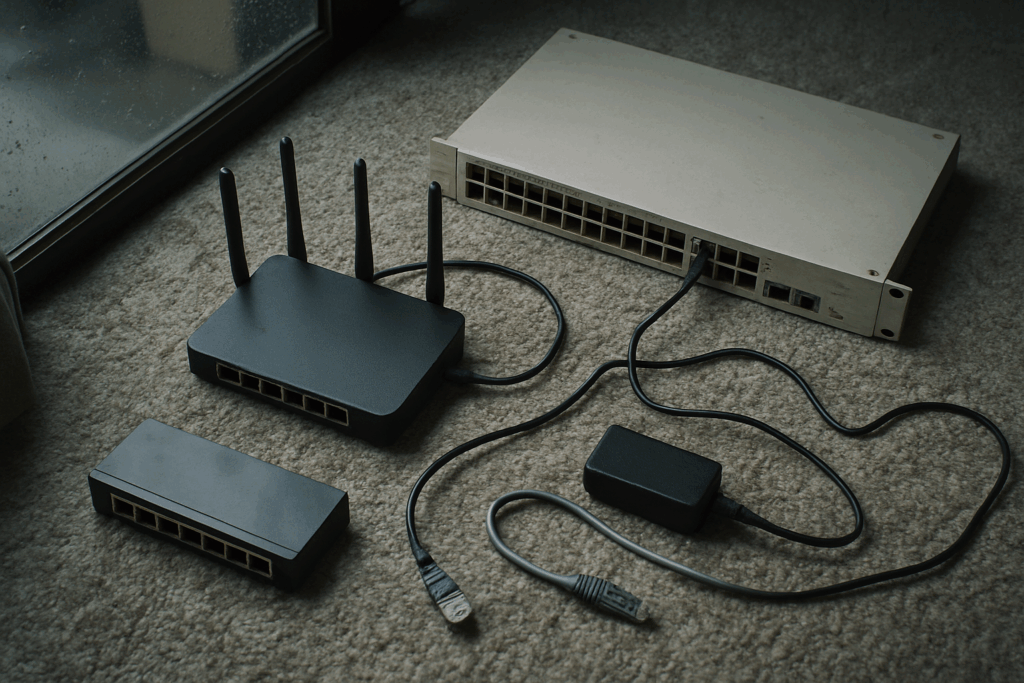What Quantum Networking Actually Is
Start with the basics. Quantum networking hinges on three core ideas: entanglement, superposition, and qubits.
Entanglement is when two quantum particles become linked what happens to one instantly affects the other, no matter how far apart they are. Superposition is the ability of a quantum particle to exist in multiple states at once, like on and off at the same time. And a qubit? That’s the quantum version of a digital bit. Instead of being just a 0 or 1, it can be both, thanks to superposition.
Now, here’s where it veers off the classical networking path. In typical networks, we transmit signals electrical or optical pulses through wires or fiber. Quantum networks don’t do that in the same way. There’s no active signal being beamed from one place to another. Instead, they use entangled particles to establish links between distant points. That “link” doesn’t carry a message it sets up a secure foundation to send quantum information after a classical signal is sent.
Which leads us to the big misconception: no, quantum entanglement doesn’t mean you can chat with someone halfway across the planet in zero seconds. It’s not teleportation. The entangled link enables ultra secure communication, not true instantaneous messaging. Think of it more like setting a locked tunnel in place. You still need a key, and that key still travels at normal speeds but the tunnel is so secure, no one can break in without you knowing.
Quantum networking is less about speed and more about security, integrity, and resilience. It’s a different kind of infrastructure built for the frontier of trust, not just bandwidth.
The current internet wasn’t built for the kind of threats and demands we face now. Traditional encryption relies on algorithms that, while robust today, become vulnerable in the face of quantum computing. A powerful enough quantum machine could crack widely used encryption schemes like RSA in a fraction of the time it takes classical computers. That’s not science fiction. It’s on the horizon.
Quantum powered cyberattacks represent a direct threat to data security across the board. Everything from bank transactions to health records and government communications could be exposed unless encryption evolves fast and quantum safe alternatives are already in development. Algorithms based on lattice based cryptography and hash based signatures are leading contenders, but adoption remains slow.
There’s also a growing strain on real time communication needs. Industries like defense, finance, and healthcare are pushing for transmission that’s not only secure but immediate and resilient. In battlefields, trading floors, and operating rooms, milliseconds matter. The race is now about building secure, low latency systems that can handle an increasingly interconnected and attack prone digital environment. Quantum networking, with its entanglement enabled advantage, has a shot at delivering exactly that if we can scale it in time.
Major Breakthroughs Happening Now
The field of quantum networking has seen significant progress over the past year, marking 2026 as a critical inflection point. From hardware advancements to international research projects, the pace of development has accelerated and real world deployment is closer than ever.
Quantum Repeaters: The Missing Link
Quantum repeaters solve one of the biggest challenges in long distance quantum communication: signal degradation.
Why we need them: Quantum information can’t be copied or boosted like traditional digital signals.
What they do: Extend the range of quantum entanglement by connecting segments of a network through entangled particles.
Recent progress: 2026 has seen lab demonstrated repeaters in urban scale environments, with better stability and fidelity than in previous years.
These advances bring the dream of a true quantum internet within reach.
Entanglement Distribution Getting Scalable
Distributing entangled particles across large distances is a cornerstone of any quantum communication system. Until recently, this was only possible in tightly controlled lab settings.
Satellite based experiments (especially from China) have connected ground stations across hundreds of kilometers.
Fiber optic integration now allows short to mid range entanglement sharing across existing infrastructure.
Hybrid models combining satellite and fiber pathways are showing promise for nationwide and intercontinental links.
Global Testbeds: Who’s Leading the Quantum Race?
Several nations and corporations are building out testbeds early stage versions of a quantum internet to trial new technologies and protocols:
United States: Integrating quantum nodes at national labs and research universities through the Department of Energy’s Quantum Internet Blueprint.
China: Extending its Beijing Shanghai quantum backbone and conducting satellite missions through the Micius platform.
European Union: Pioneering cross border collaboration under the EuroQCI (Quantum Communication Infrastructure) initiative.
Private sector involvement is also rising with quantum focused startups and tech giants (such as IBM and Google) investing heavily in prototype networks.
Why 2026 Is a Pivotal Year
Several factors now intersect to drive tangible progress:
Stabilization of quantum memory and photon generation techniques has improved consistency.
Policy momentum around national quantum strategies has unlocked funding and sped up collaboration.
Hardware miniaturization and cost reduction make testbed expansion more feasible.
Taken together, these advancements turn what was a research fantasy just a few years ago into a technology with a clear path to implementation.
Real World Applications Arriving Sooner Than Expected

Quantum networking isn’t just theory it’s already being tapped for real world impact. In the finance world, tamper proof authentication is redefining how transactions are secured. With quantum keys, the risk of interception drops close to zero. Every transfer, every signature, becomes virtually unhackable.
Governments and defense sectors are also paying attention. Quantum secure communication channels are being used to coordinate military operations without the usual fears of leaks or cyber intrusion. In an age where information moves faster than boots on the ground, locking down strategic data is critical.
Then there’s healthcare. Telemedicine is leaning hard on high speed, ultra secure data transfer think oncology consults, robotic surgery guidance, and biotech devices transmitting sensitive biosignals in real time. The stakes here aren’t just technical they’re personal.
For a deeper look at biotech’s intersection with next gen tech, check out Biotech Meets AI: Current Innovations Disrupting Healthcare.
What Needs to Happen Next
Quantum networking is inching closer to real world implementation, but a few significant hurdles remain. To move from research labs to widespread deployment, we need more than just breakthroughs we need systems, standards, and skills.
Upgrading the Infrastructure
Quantum communication requires an overhaul of traditional networking infrastructure. Existing systems built for classical data transmission aren’t optimized for quantum bits (qubits), which behave very differently.
Key areas of development include:
Fiber Optic Networks: New types of optical fibers are needed to preserve quantum states over long distances.
Quantum Repeaters: Unlike classical signal boosters, these are needed to maintain entanglement and prevent decoherence during transmission.
Satellite Based Relays: Linking satellites with quantum communication capabilities can extend global coverage especially to remote or geopolitically sensitive regions.
Quantum Nodes: Local hubs that can transmit, store, and process quantum information securely.
Building a Global Standard
To scale quantum networking, we can’t afford a fragmented approach. Much like TCP/IP standardized the classical internet era, we need consistent global protocols for quantum networking.
Steps needed for cross border collaboration:
International Standards Bodies must define baseline specifications for data transfer, encryption, and network handoffs.
Policy Coordination between major powers such as the U.S., China, and the EU is essential to prevent incompatible or isolated implementations.
Bilateral and Multilateral Agreements to ensure that research, data security practices, and infrastructure deployments can work across borders.
Closing the Talent Gap
No transformation can be sustained without a qualified workforce. Quantum information science is still a niche field, and there aren’t enough trained professionals ready for this leap.
Urgent talent development goals:
Universities and Technical Institutions need new programs focused on quantum hardware, software, and theory.
Interdisciplinary Training combining quantum physics with computer science, engineering, and cybersecurity.
Private Public Partnerships to create internships, fellowships, and apprenticeships that attract and train new talent.
Without these foundational developments, even the most advanced quantum technologies will remain confined to research labs. The future hinges not just on discovery but on readiness.
Bottom Line: Prepare for the Shift
We’re not tearing down the internet and replacing it with quantum overnight. This will be a slow, structural evolution one layer at a time. But make no mistake: the shift has already started. Countries are laying fiber for quantum communication, labs are launching stable entanglement links, and private players are field testing encrypted networks that can’t be hacked by future quantum computers.
Organizations that wait on the sidelines will fall behind. The advantage won’t go to the biggest or flashiest, but to those who understand what’s coming and start adapting now. That means leaning into research, finding partners in quantum networks, and figuring out how next gen communication can fit into your operation. Think of it less like replacing your toolbox, more like building a smarter, faster layer on top of it.
We’re heading into a world where communication becomes nearly impossible to intercept, latency drops close to zero, and data integrity reaches a new standard. Security, speed, and reliability done right, quantum networking delivers all three. The organizations that start preparing today? They’re setting themselves up to lead tomorrow.
